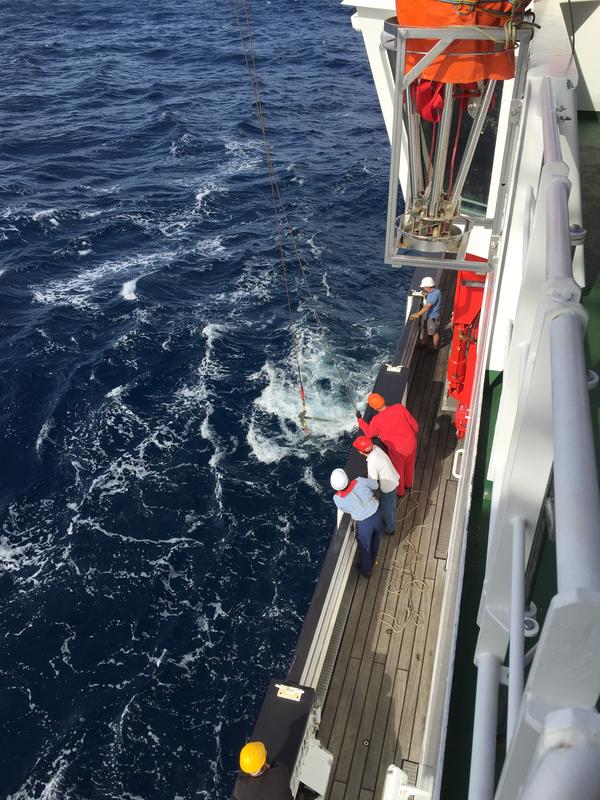Earthquake impact on submarine slopes: subtle erosion versus significant strengthening

Scientists and shipboard crew await the arrival of a new sediment core onboard research vessel RV Sonne in 2016. T. Schwestermann
Whereas most previous research assumed that sediment transport by earthquakes only happened by sliding of sediment packages (i.e. submarine landslides), that are several meters thick, the recently-discovered process of surficial remobilization involves the stripping of only a thin veneer of sediment over an extensive area.
At first view a few missing centimeters of sediment do not look very spectacular. However, the fact that it affects a vast area has tremendous implications for all studies based on the remobilization of marine sediment by earthquakes, such as research on pre-historical earthquakes, deposition of organic carbon into the deep ocean and even the potential tsunami hazard by submarine landslides.
“Surficial remobilization was hypothesized based on studies of basin deposits. However, to really understand this important process it is crucial to investigate the place where it takes place: the submarine slopes”, explains Jasper Moernaut, Assistant Professor at the Institute of Geology.
Mind the gap
The researchers combined chemical and physical analyses to detect small centimeter scale gaps in the sediment taken from a slope offshore Japan. Subsequent dating then revealed the potential of the gaps being caused by seismic shaking.
“We were quite amazed when we found that not only one, but three gaps were present in this small 15 cm section of sediment core”, says Ariana Molenaar, PhD student at the Institute of Geology. “When we dated these three gaps we found that they link to the three strongest regional earthquakes with a magnitude larger than eight, indicating that this is a systematically repeating process.”
No one before has examined deep sea slopes with this method. A slope site where erosion takes place is surely the last place one would take a sediment core. “Our pilot study is the first to target a submarine slope to investigate this process, showing the potential of this method”, says Michael Strasser, Professor at the Institute of Geology. The research team is now applying their strategy in different settings – even in lakes − to further advance their understanding of this newly-discovered process.
Contrasting effect on submarine slopes
Besides the shedding of the uppermost few centimeters, earthquake shaking has another very contrasting effect on the submarine slope: the sediments that remain actually get stronger. This process, called “seismic strengthening”, occurs due to the compaction of sediments by violent shaking.
“In the ocean, this leads to very stable slope sequences and thus a remarkable absence of submarine landslides”, says Jasper Moernaut. So the good news is that − despite the frequent occurrence of strong earthquakes at active ocean margins − tsunamis triggered by submarine landslides are relatively uncommon in these regions.
Ariana Willemina Molenaar, MSc
Tel.: +43 512 507 54232
Mail: Ariana.Molenaar@uibk.ac.at
https://dx.doi.org/10.1029/2019GL082350
Earthquake Impact on Active Margins: Tracing Surficial Remobilization and Seismic Strengthening in a Slope Sedimentary Sequence. Ariana Molenaar, Jasper Moernaut, Gauvain Wiemer, Nathalie Dubois, Michael Strasser. DOI: 10.1029/2019GL082350
Media Contact
More Information:
http://www.uibk.ac.atAll latest news from the category: Earth Sciences
Earth Sciences (also referred to as Geosciences), which deals with basic issues surrounding our planet, plays a vital role in the area of energy and raw materials supply.
Earth Sciences comprises subjects such as geology, geography, geological informatics, paleontology, mineralogy, petrography, crystallography, geophysics, geodesy, glaciology, cartography, photogrammetry, meteorology and seismology, early-warning systems, earthquake research and polar research.
Newest articles

Bringing bio-inspired robots to life
Nebraska researcher Eric Markvicka gets NSF CAREER Award to pursue manufacture of novel materials for soft robotics and stretchable electronics. Engineers are increasingly eager to develop robots that mimic the…

Bella moths use poison to attract mates
Scientists are closer to finding out how. Pyrrolizidine alkaloids are as bitter and toxic as they are hard to pronounce. They’re produced by several different types of plants and are…

AI tool creates ‘synthetic’ images of cells
…for enhanced microscopy analysis. Observing individual cells through microscopes can reveal a range of important cell biological phenomena that frequently play a role in human diseases, but the process of…





















